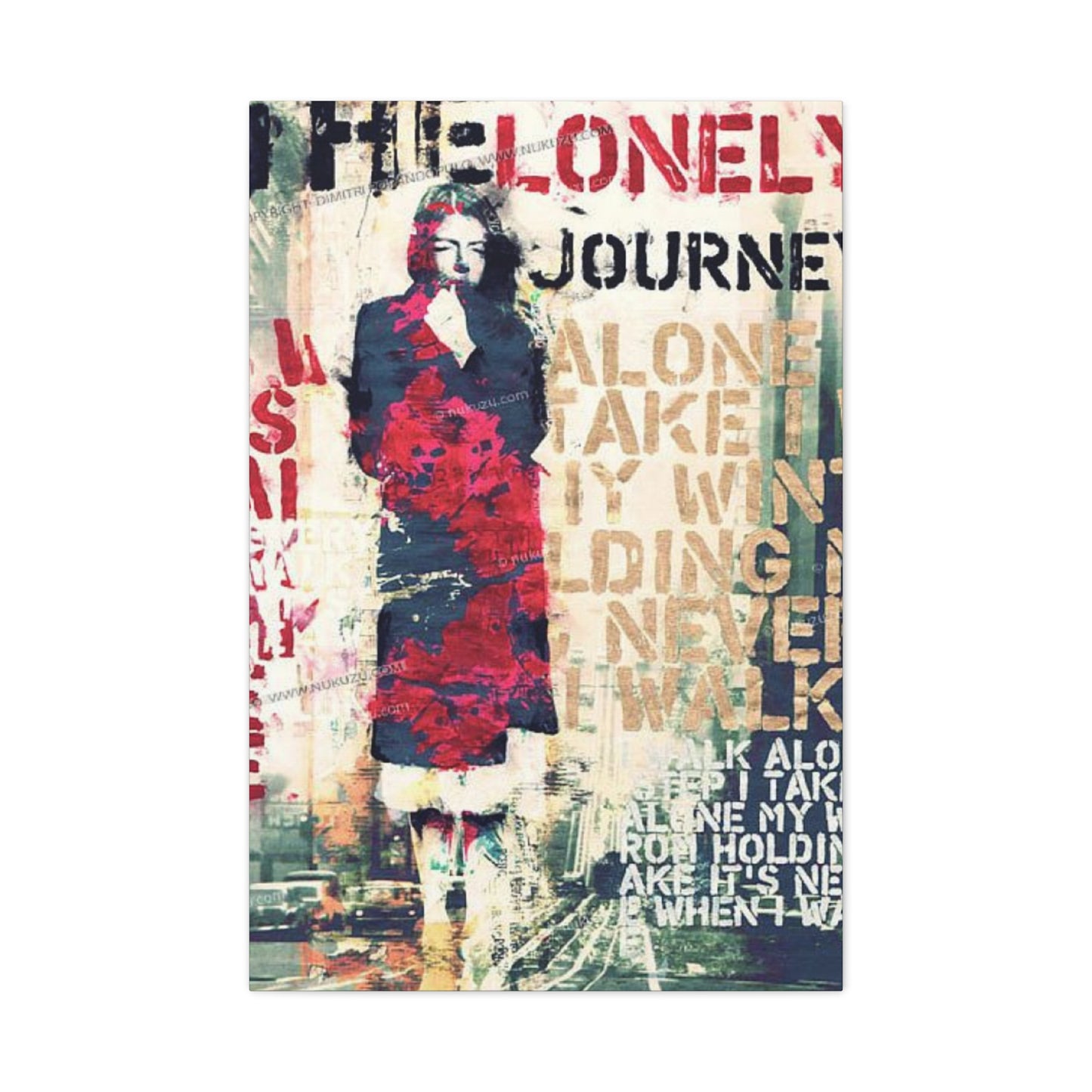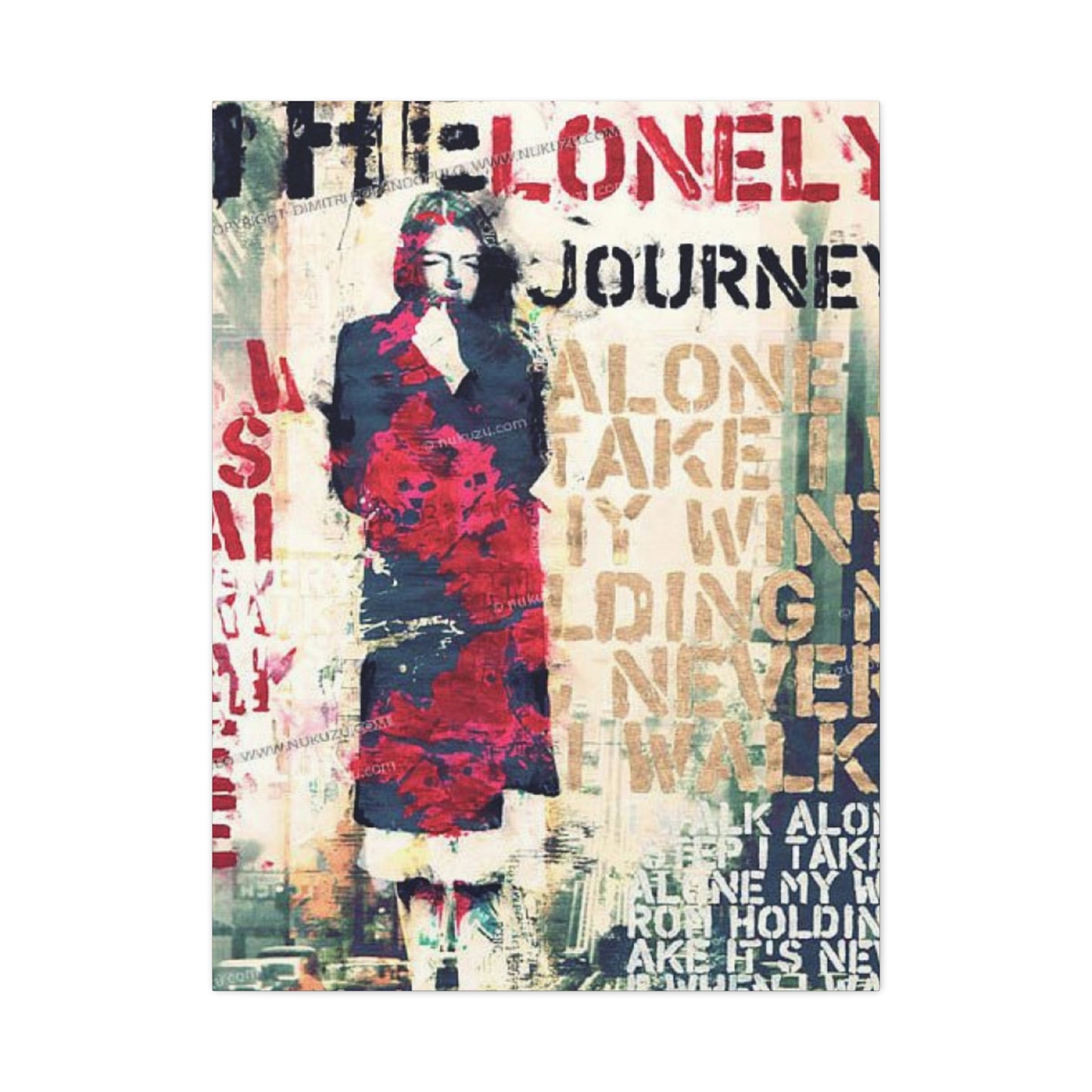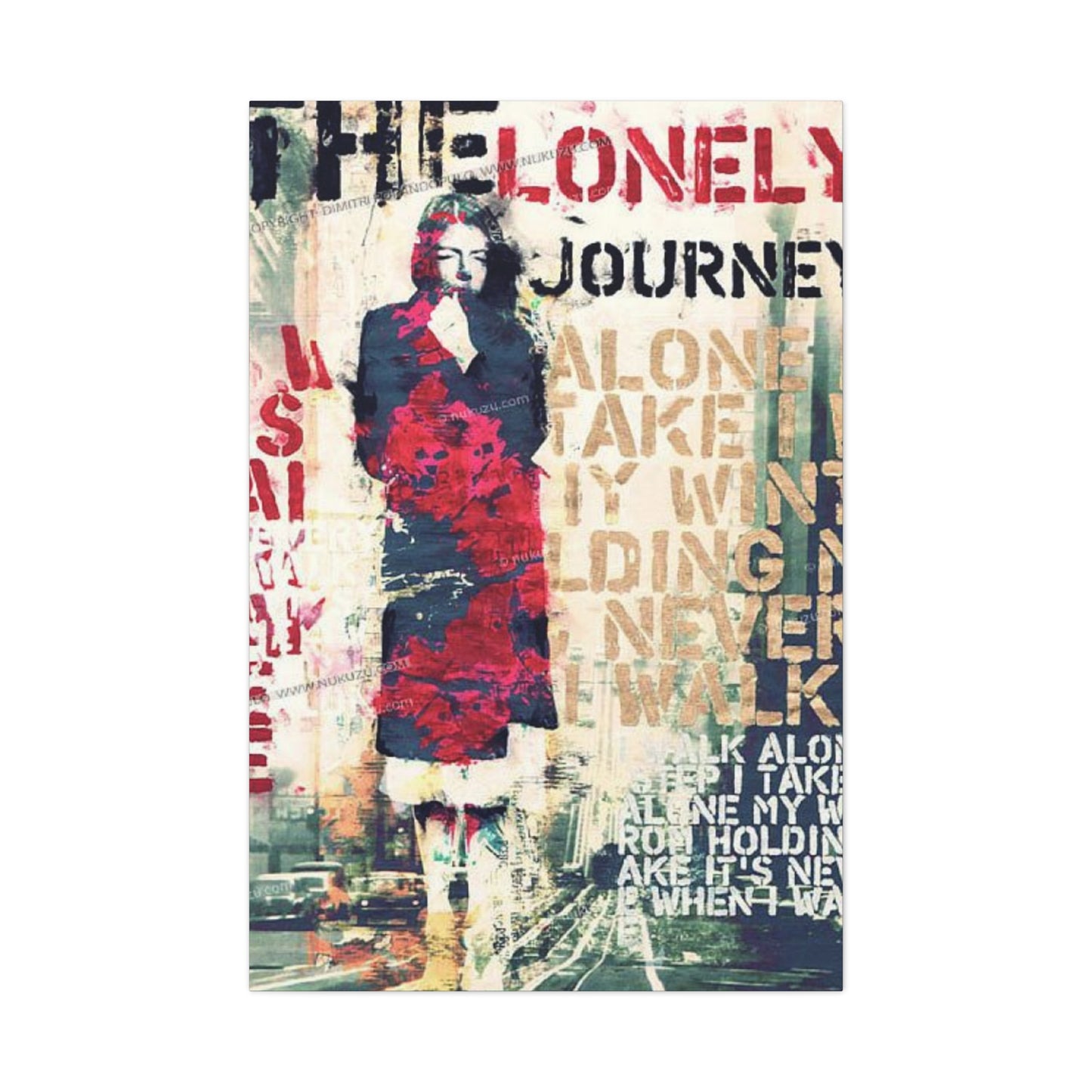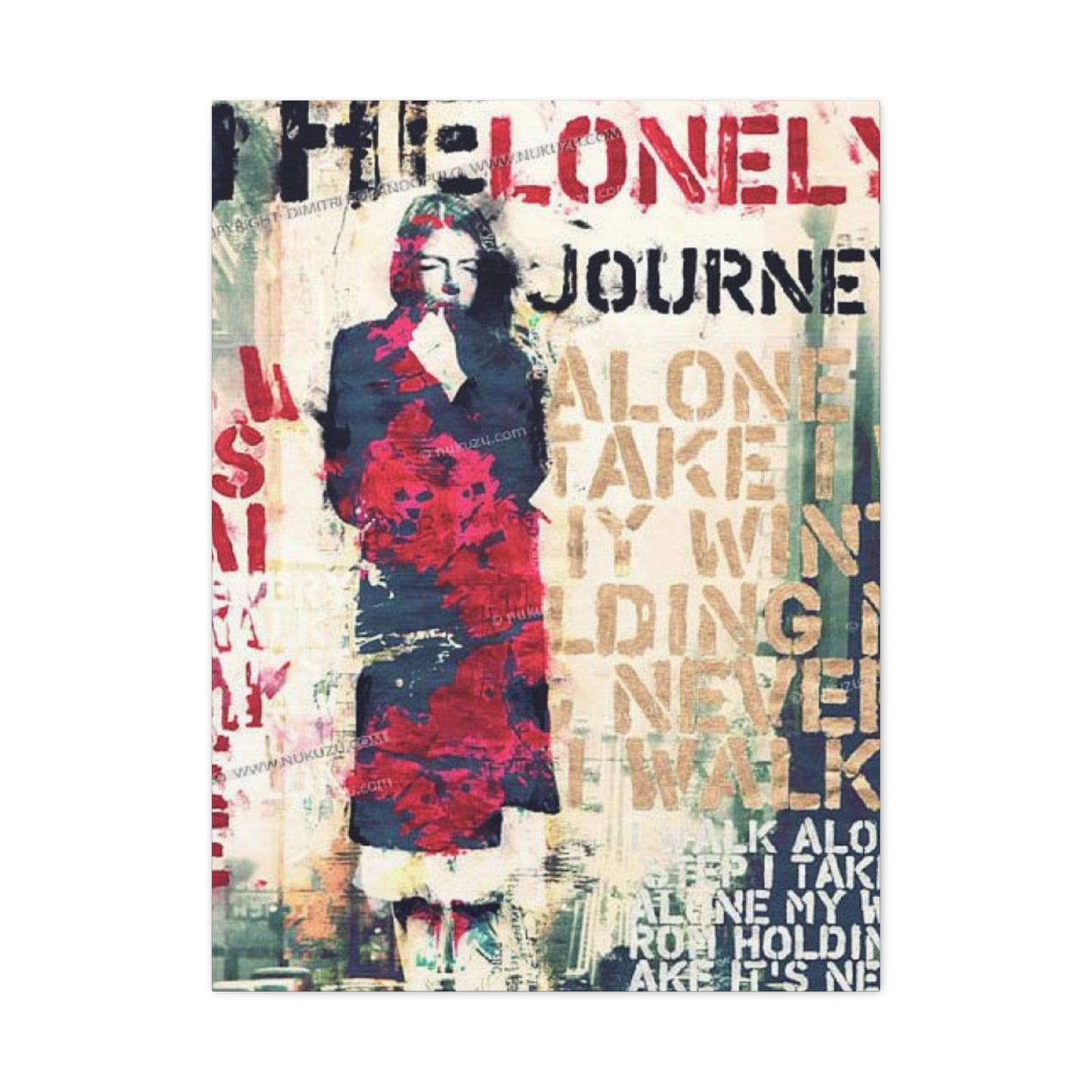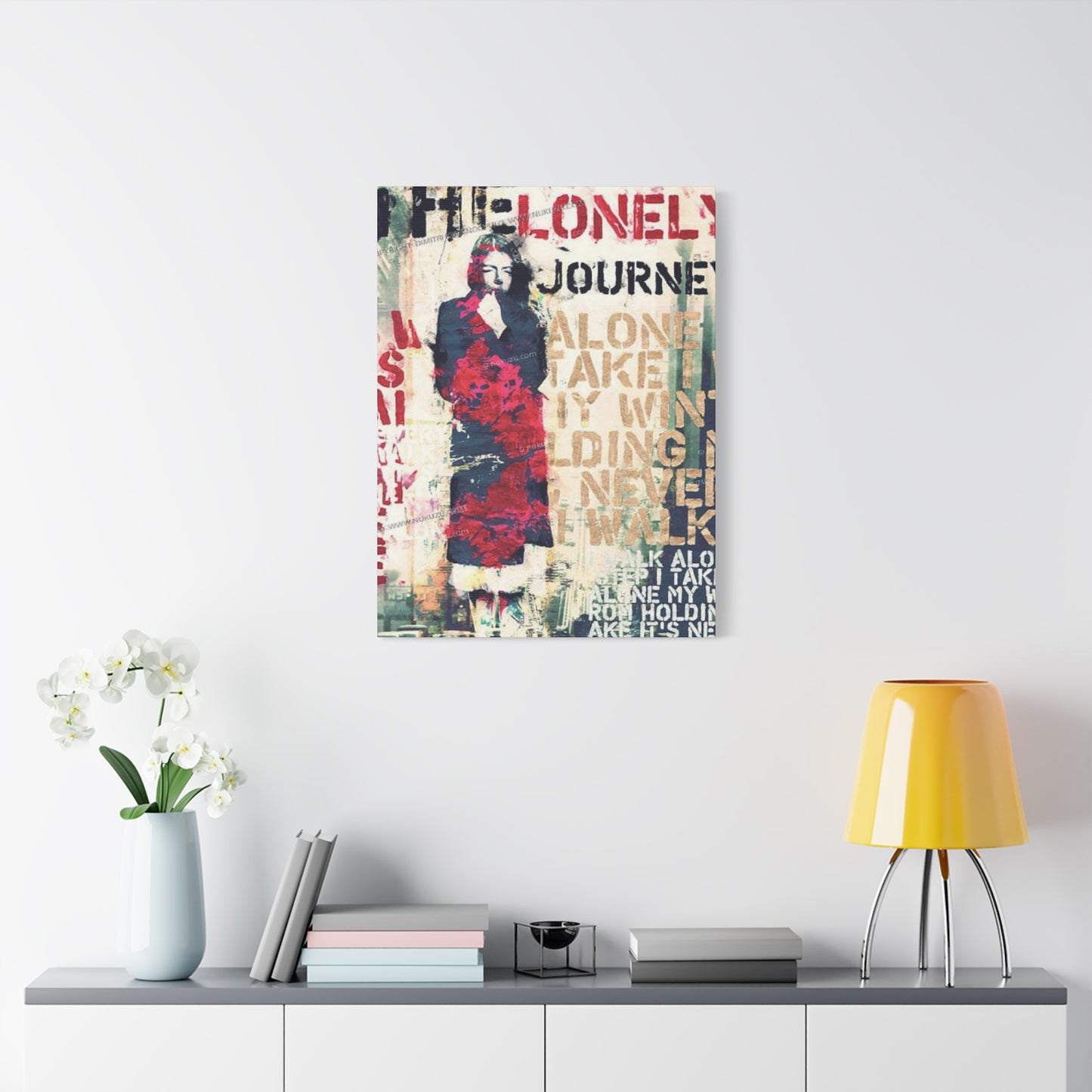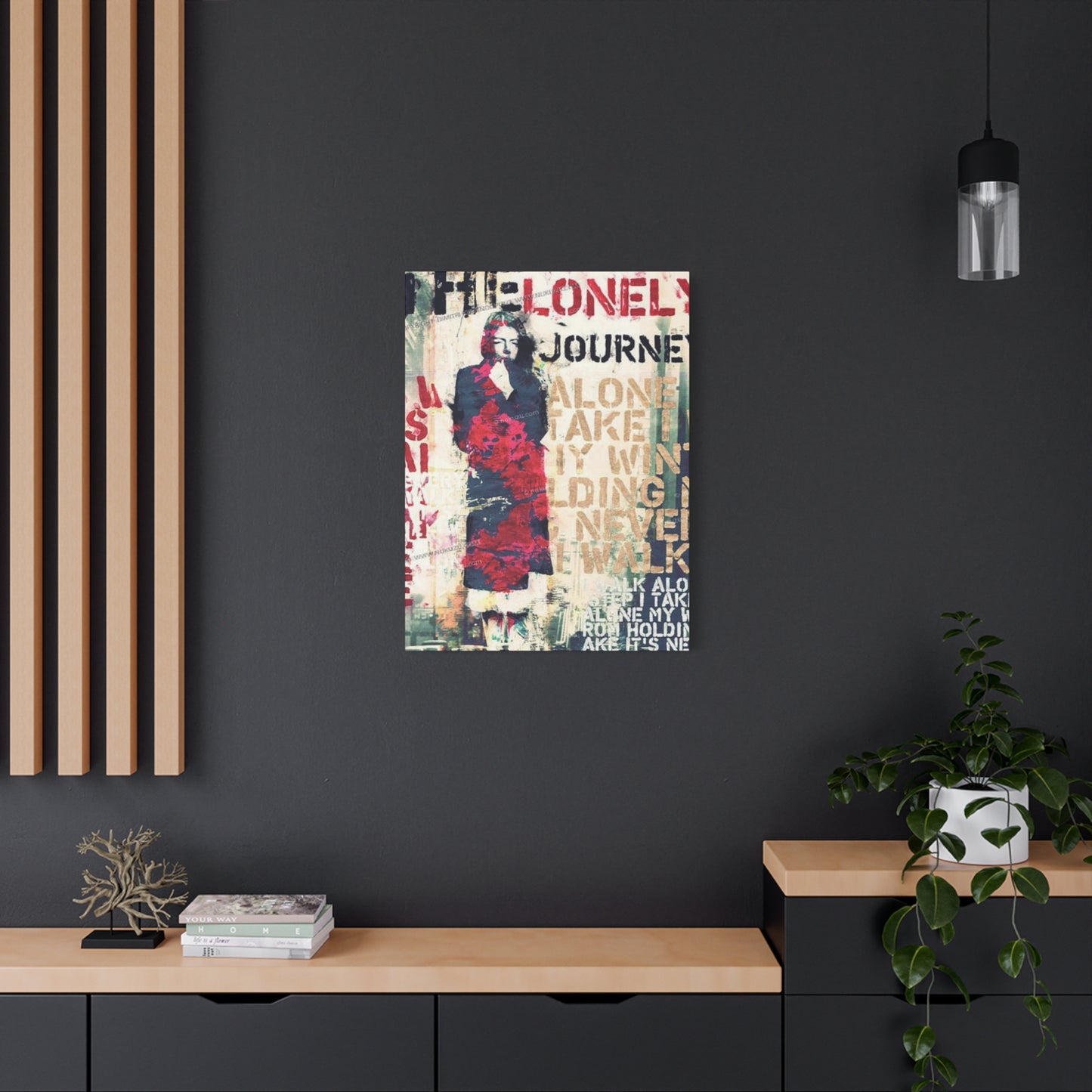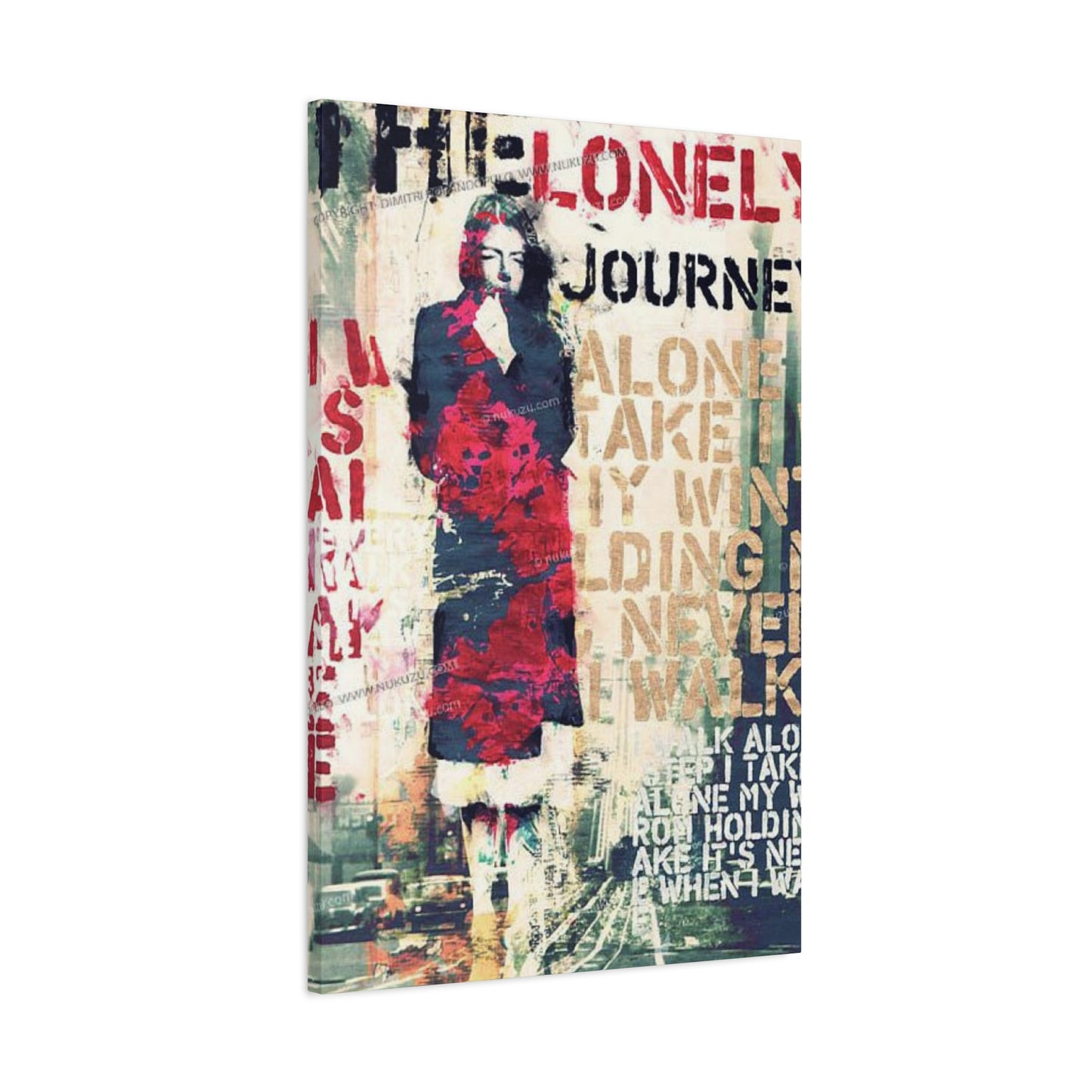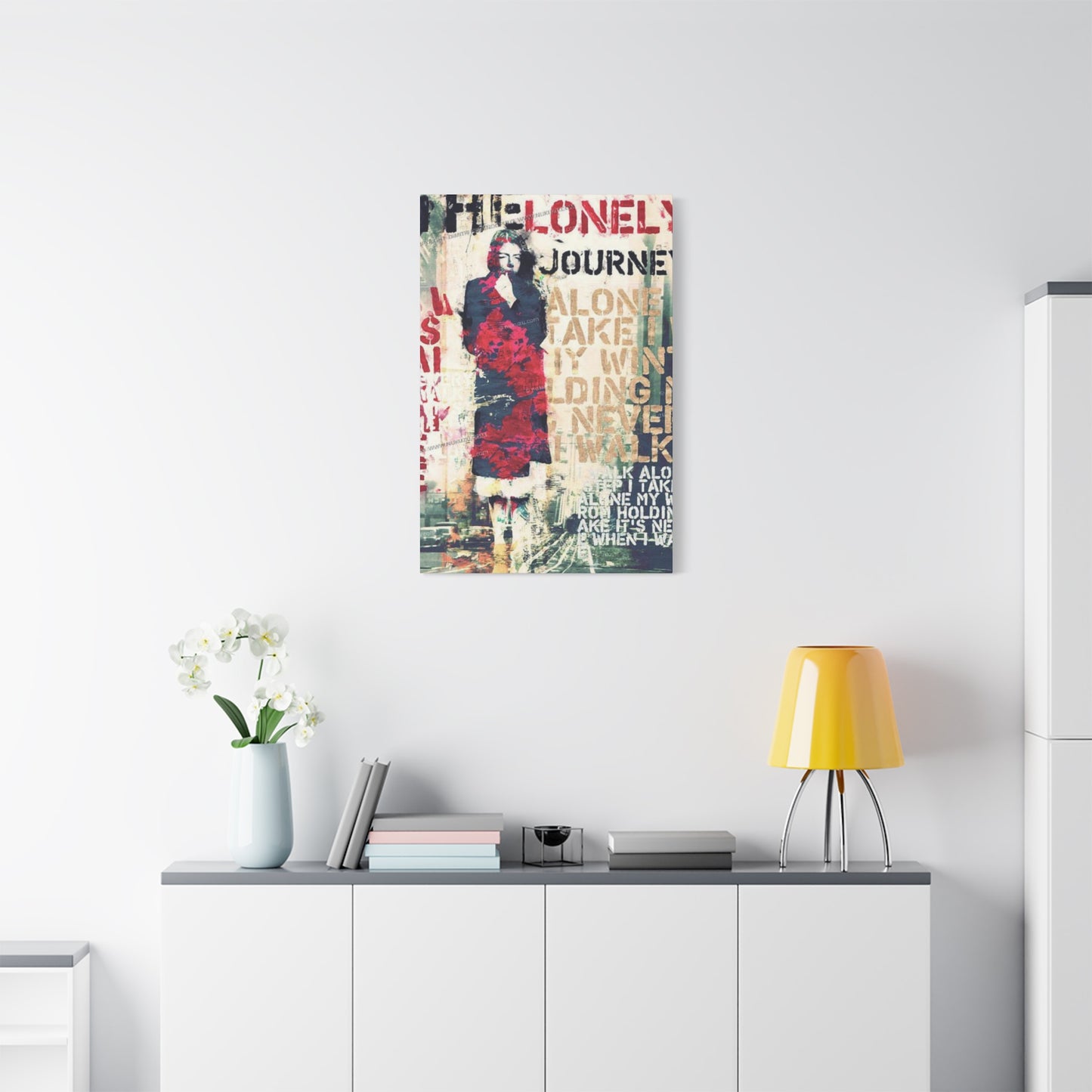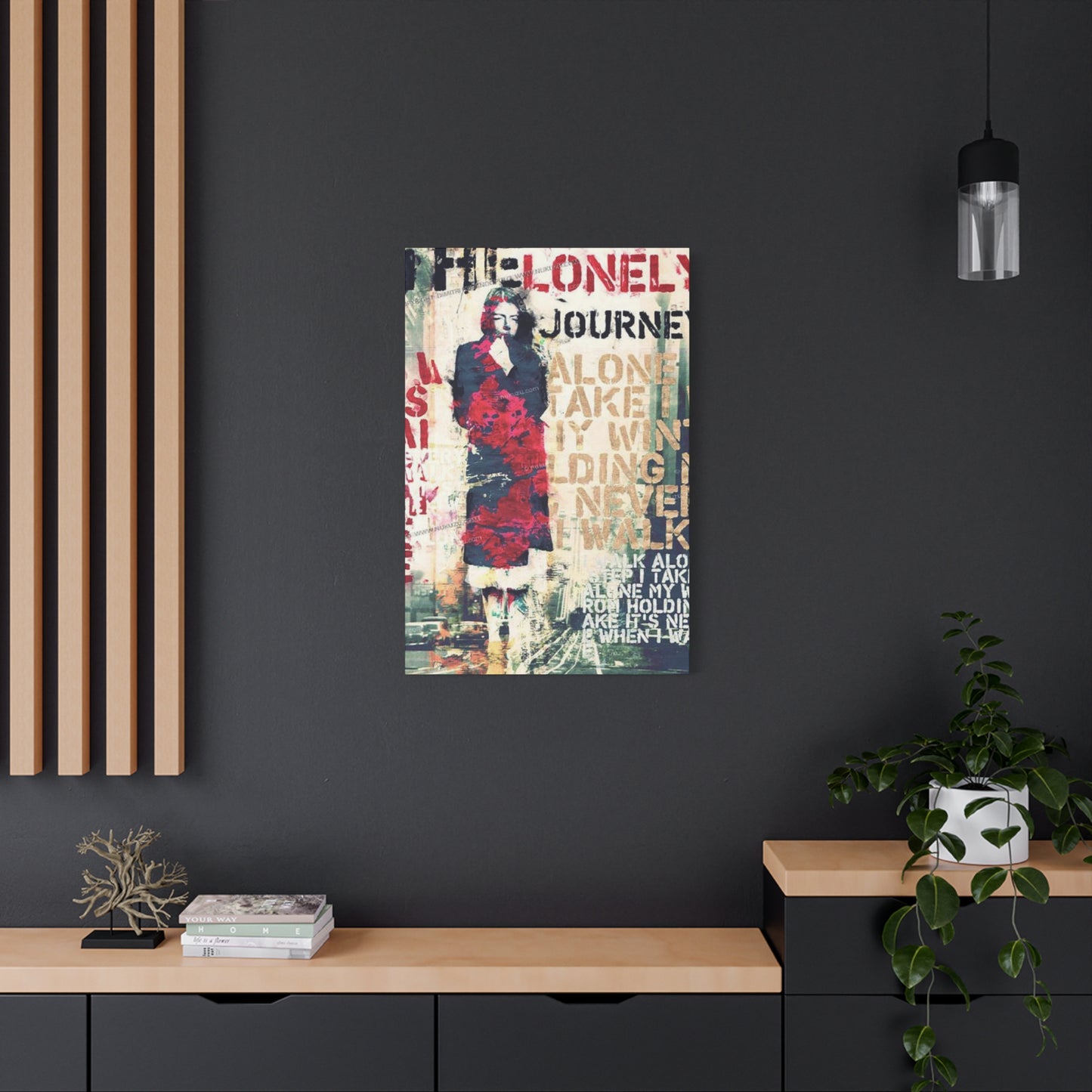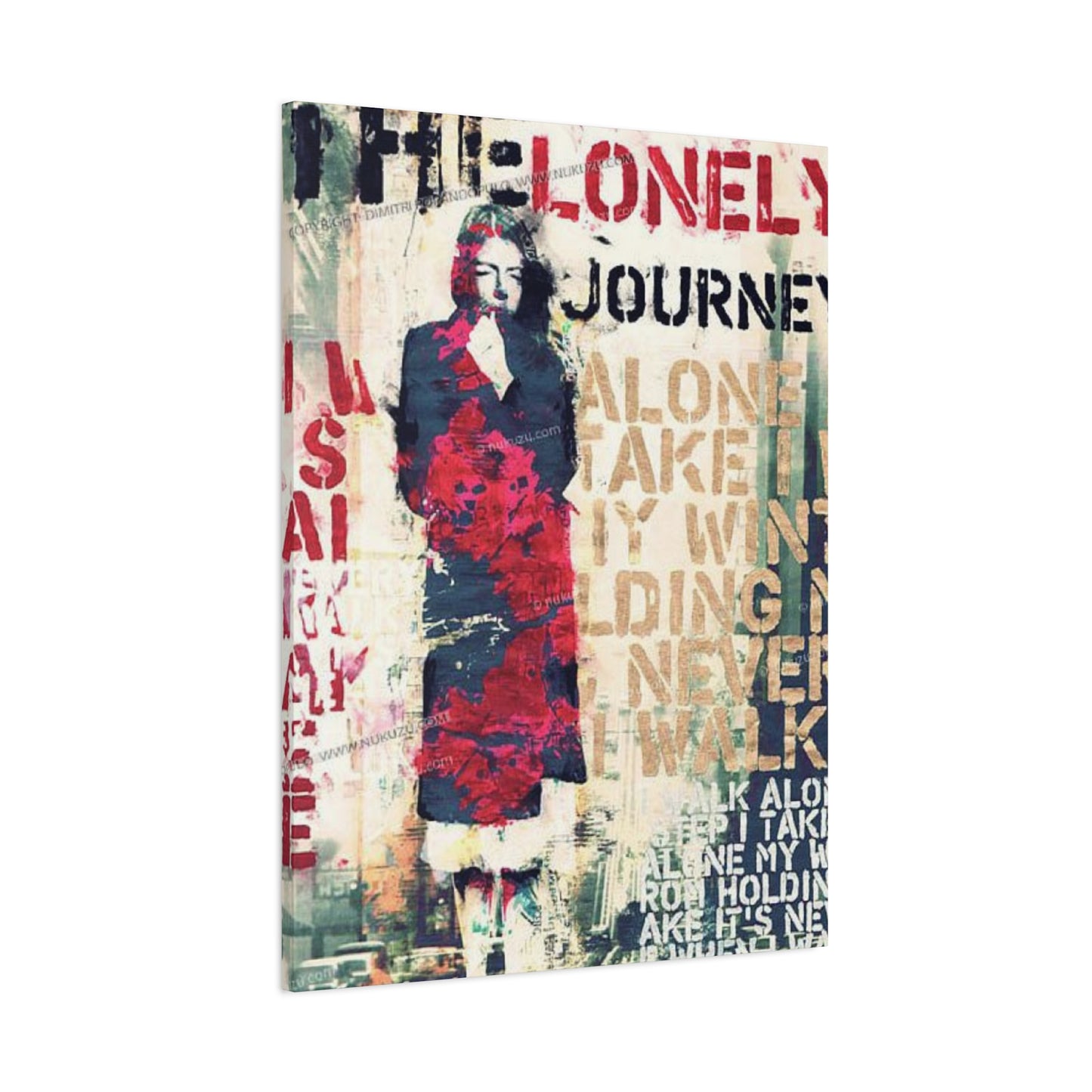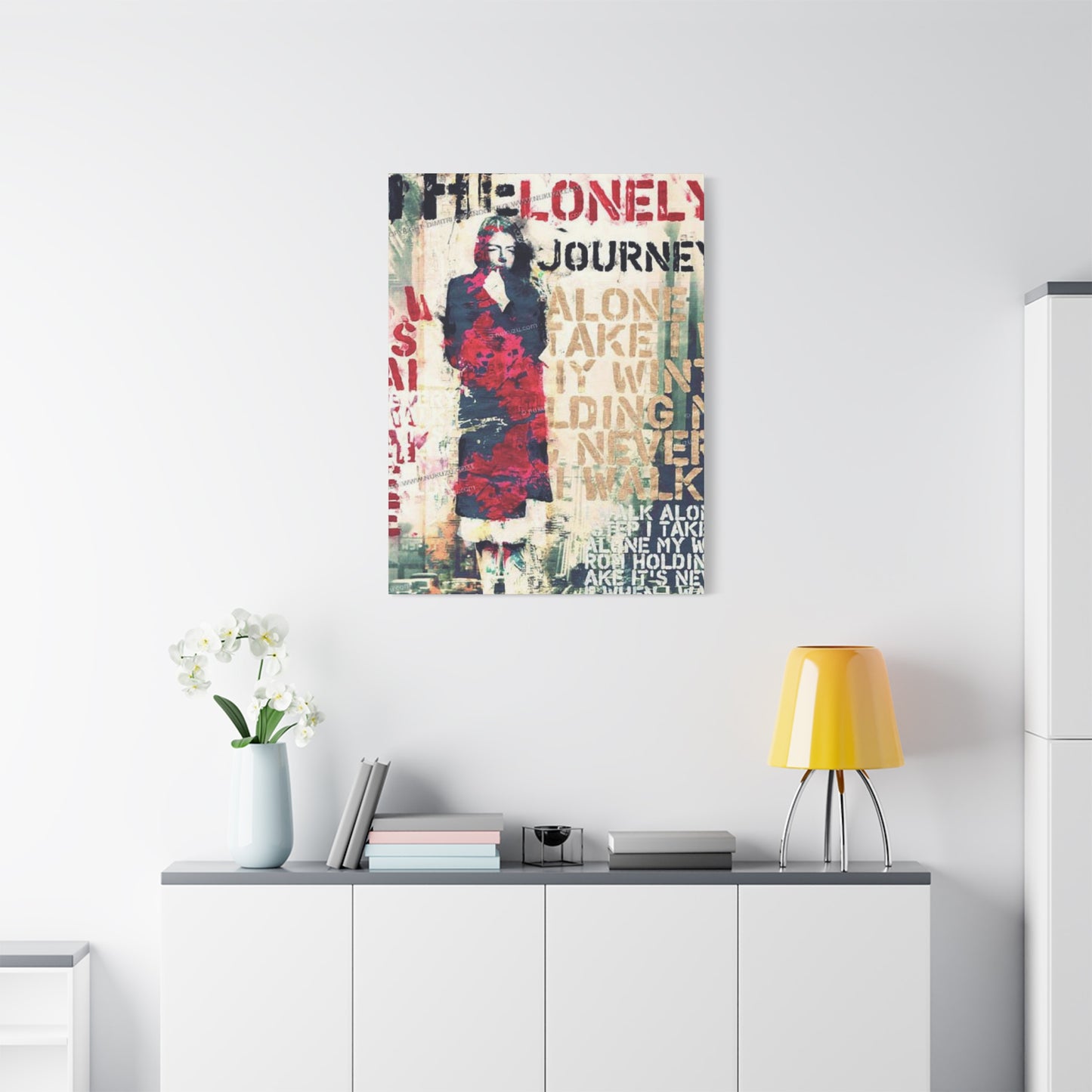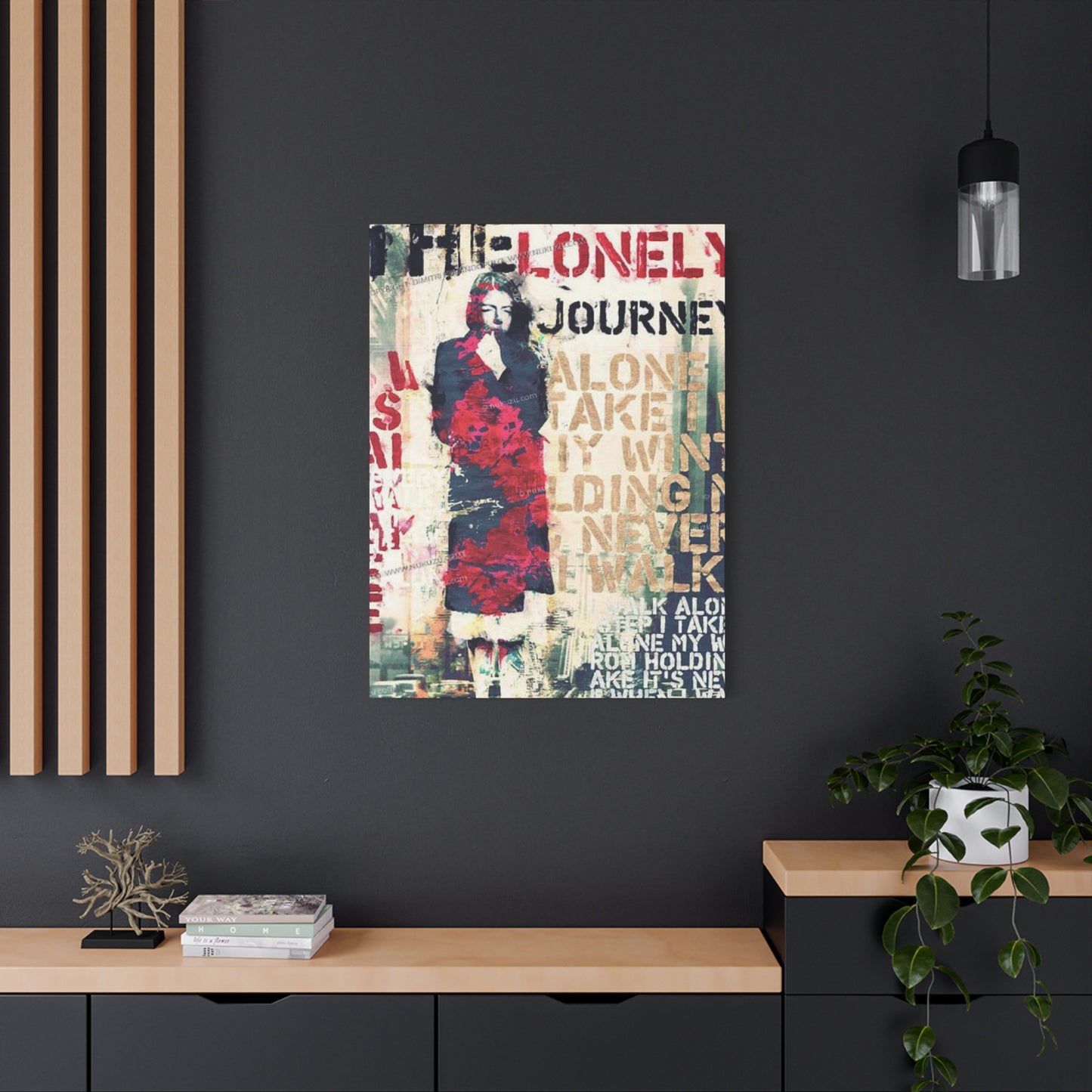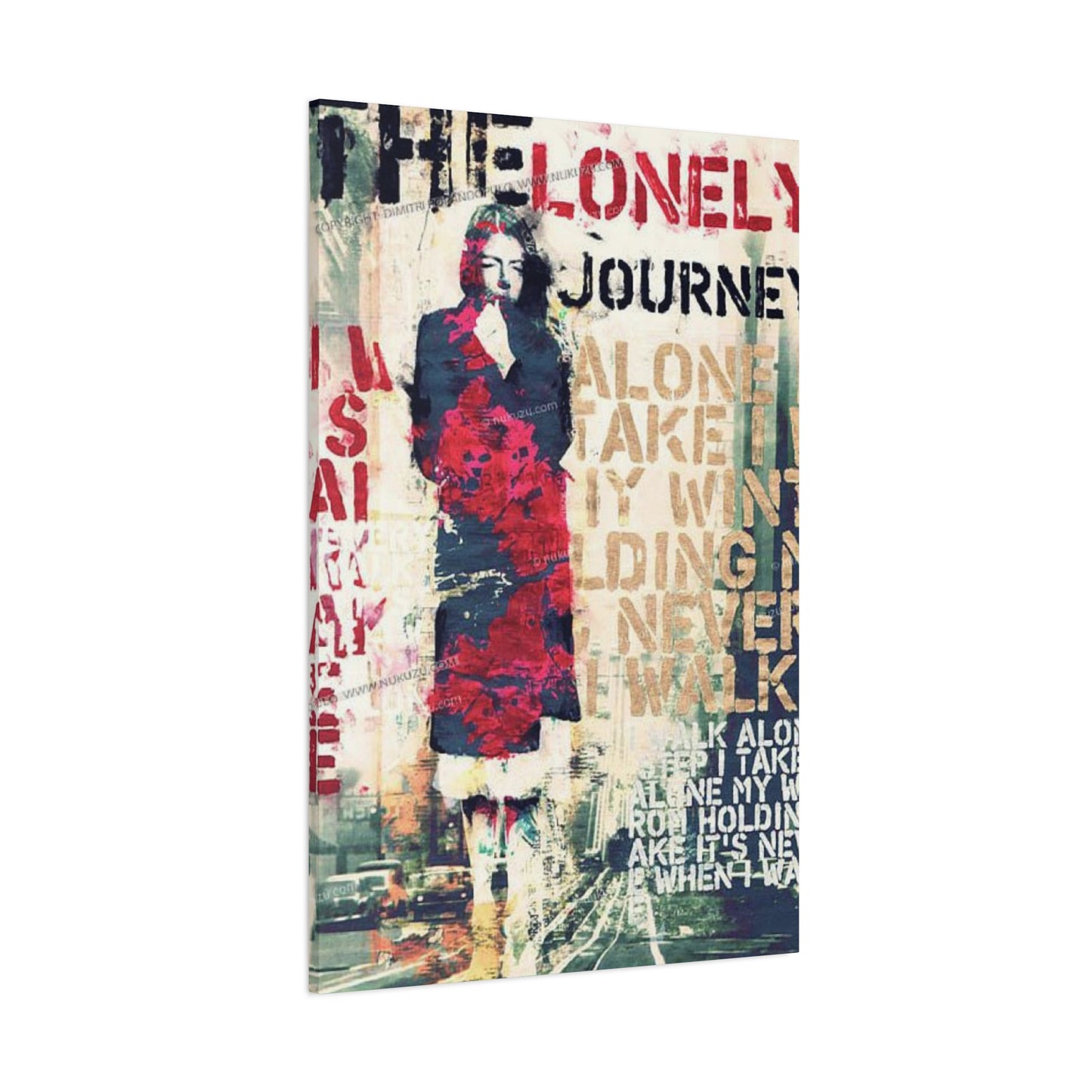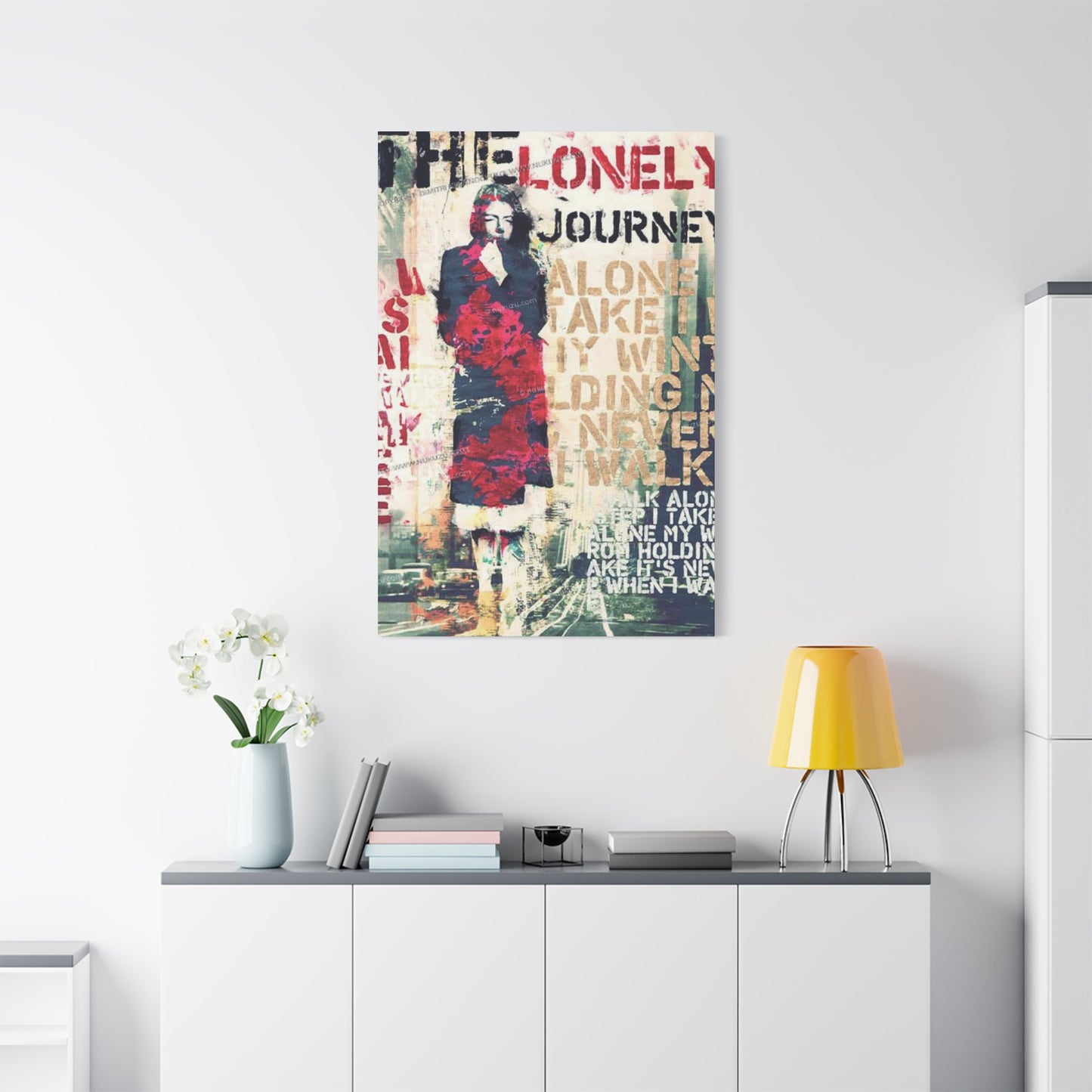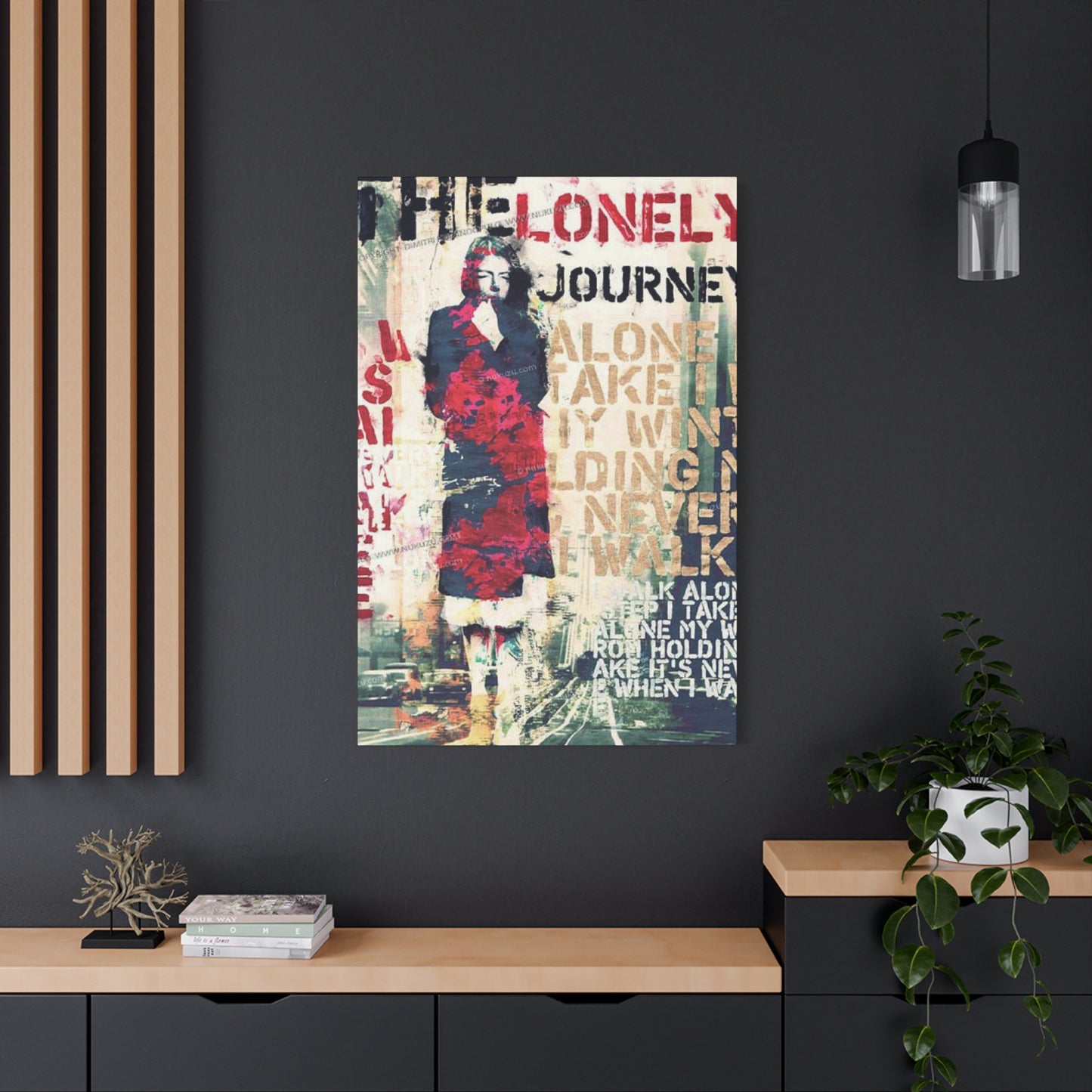The Soul of Solitude: A Deep Dive into the Lonely Journey Waterfall Abstract Painting as Wall Art
The world of artistic expression offers a profound mirror to the human condition, capturing fleeting emotions, complex philosophies, and the silent, powerful beauty of the natural world. Among the myriad forms of creative output, a particular piece of wall art can resonate with an individual’s soul, speaking a language that words often fail to articulate. The "Lonely Journey Waterfall Abstract Painting Mixed Media Wall Art Canvas Prints" is one such creation. It is not merely a decorative object but a deep, contemplative narrative rendered in pigment and texture. This composition invites the viewer to embark on a personal odyssey, to explore the nuanced relationship between solitude, nature, and the inner self. It captures the essence of a solitary path, flanked by the relentless, cleansing power of a waterfall, all filtered through the evocative lens of abstraction. This extensive exploration will delve into every facet of this remarkable artwork, from its thematic underpinnings and technical execution to its transformative potential within a personal setting. We will unpack the layers of meaning embedded within the abstract forms, analyze the choice of mixed media, and celebrate the enduring power of canvas prints as a medium for bringing such profound visions to life.
Deconstructing the Visual Narrative of the Lonely Journey Waterfall Abstract Painting
At its core, the Lonely Journey Waterfall Abstract Painting tells a story without a single explicit character or event. Its narrative is woven through the interplay of color, form, and texture, inviting a deeply personal interpretation from every observer. The "lonely journey" aspect is not depicted as a desolate or sorrowful experience; rather, it suggests a path of introspection, self-discovery, and quiet strength. This journey might be represented by a subtle line, a shift in color, or a textural pathway that moves across the canvas. It is a visual metaphor for the personal odysseys we all undertake, whether they are emotional, spiritual, or intellectual. The artist uses abstraction to distill this complex theme into its purest emotional essence. Instead of a literal path or a figure walking alone, we are presented with swathes of color that suggest movement and direction, perhaps a darker, more concentrated area giving way to a lighter, more expansive one, symbolizing progress through challenges toward enlightenment or understanding. The composition guides the eye, creating a sense of passage through the visual field, mimicking the progression of a long and thoughtful trek. The journey is solitary, but it is also rich with the internal dialogue and profound observations that only solitude can afford. This piece of wall art becomes a companion for one's own contemplative moments.
The Emotional Resonance of a Solitary Expedition in Abstract Form
A solitary expedition, when translated into abstract art, transcends a simple depiction of being alone. It becomes an exploration of the internal landscape. The "Lonely Journey Waterfall Abstract Painting" taps into a universal human experience: the need for introspection and the powerful emotions that surface when one is truly alone with their thoughts. The abstract nature of the work allows it to connect with a broad spectrum of feelings. For one viewer, the journey might evoke a sense of peaceful melancholy, a quiet acceptance of solitude as a necessary part of growth. For another, it might represent a courageous venture into the unknown, a deliberate choice to step away from the noise of the world to find one's own truth. The artist achieves this emotional depth through a masterful manipulation of visual elements. Cool tones like blues and grays might suggest the contemplative and sometimes somber aspects of solitude, while sudden bursts of warmer colors—golds, oranges, or reds—could signify moments of epiphany, bursts of creative energy, or the warmth of self-realization found along the path. The artwork’s power lies in its ambiguity; it does not dictate a single emotion but provides a framework for the viewer to project their own experiences and feelings onto the canvas. It becomes a deeply personal artifact, a visual sounding board for the soul’s quietest conversations.
The Power and Symbolism of the Waterfall Motif in Artistic Expression
The waterfall is a potent and enduring symbol in art and literature, representing a multitude of powerful concepts, all of which are harnessed in this abstract composition. A waterfall is a manifestation of nature’s raw, untamable force. It symbolizes constant change, the relentless flow of time, and the unstoppable momentum of life itself. In the context of a "lonely journey," the waterfall can be seen as a formidable obstacle that must be navigated, a representation of the major challenges and life-altering events we face. Yet, a waterfall is also a source of cleansing and renewal. The cascading water washes away the old, purifies the spirit, and offers a sense of rebirth. This duality is central to the artwork’s meaning. The journey may be difficult, but it is also transformative and cleansing. The abstract representation of the waterfall might be a torrent of vertical brushstrokes, a cascade of shimmering, textured materials, or a dominant flow of color that bisects the canvas. This element introduces a dynamic energy into the composition, a counterpoint to the quiet, horizontal movement of the journey. It is the moment of climax, the point of no return, and the promise of a fresh start. This powerful motif ensures that the wall art is not a static image but a vibrant, living representation of the cycles of struggle and release.
Exploring the Rich Textures of Mixed Media Wall Art
The designation of this piece as "mixed media wall art" is crucial to its impact and depth. Mixed media refers to the use of multiple materials in the creation of a single artwork. This could include a combination of acrylics, oils, ink, paper, fabric, sand, or even metallic elements applied to the canvas. This technique liberates the artist from the confines of a single medium, allowing for an extraordinary range of expressive possibilities. In the Lonely Journey Waterfall Abstract Painting, the use of mixed media adds a tactile dimension that invites not just visual but also sensory engagement. The waterfall might be rendered with a thick, glossy gel medium to mimic the sheen of water, while the path of the journey could be created with a gritty, sand-like texture that evokes the earthiness of a physical trek. These variations in surface create a landscape that feels almost real, despite its abstract nature. The light catches each different texture in a unique way, causing the artwork to shift and change its appearance throughout the day. This textural richness makes the canvas a dynamic and endlessly fascinating object to behold. It encourages closer inspection, rewarding the viewer with new discoveries upon each viewing and adding a layer of sophisticated complexity that a simple painting might lack.
Why Canvas Prints Are the Ideal Medium for This Abstract Masterpiece
The choice to render this artwork as a canvas print is a deliberate one that enhances both its aesthetic appeal and its accessibility. Canvas has been the preferred surface for artists for centuries, and for good reason. Its woven texture adds a subtle depth and warmth to the final image, preventing it from feeling flat or sterile. When a high-resolution image of the original mixed media piece is professionally printed onto canvas, it retains much of the original’s textural nuance and color vibrancy. Modern printing technology, such as the giclée process, uses archival inks that can reproduce an incredibly wide gamut of colors with stunning accuracy and longevity. This ensures that the deep blues, vibrant whites, and subtle earthy tones of the Lonely Journey Waterfall Abstract Painting are rendered with breathtaking fidelity. Furthermore, canvas prints are typically stretched over a wooden frame, giving them a "gallery-wrapped" edge. This means the image extends around the sides of the frame, creating a clean, three-dimensional presence on the wall that requires no additional framing. This modern presentation complements the abstract style of the artwork perfectly, allowing it to command attention and integrate seamlessly into a variety of room compositions without the distraction of a cumbersome frame.
The Philosophy of Abstraction: Interpreting Emotion Over Reality
Abstract art represents a fundamental shift in artistic intention, moving away from a literal representation of the world toward a more direct expression of emotion, ideas, and internal states. The Lonely Journey Waterfall Abstract Painting is a prime example of this philosophy in action. It does not show you a realistic waterfall or a discernible path; instead, it makes you feel the essence of these things. Abstraction bypasses the analytical part of the brain that seeks to identify objects and speaks directly to the emotional and intuitive centers. The artist uses the universal language of color, line, and form to communicate. A jagged, aggressive brushstroke can convey turmoil or conflict, while a soft, blended area can evoke a sense of peace and harmony. The "lonely journey" is not a physical place but a state of being, and abstraction is the perfect vehicle to explore such an intangible concept. This approach invites active participation from the viewer. Instead of being a passive recipient of a pre-defined image, the observer becomes a co-creator of meaning, bringing their own life experiences, memories, and emotions to the interpretation of the work. This personal engagement is what makes abstract wall art so powerful and enduring; the artwork evolves with the viewer, offering new insights and reflections over time.
Integrating Abstract Waterfall Wall Art into Your Personal Environment
Bringing a piece like the Lonely Journey Waterfall Abstract Painting into your home is about more than just filling a blank wall; it is about curating an atmosphere and infusing your personal setting with meaning and emotion. The key to successfully integrating this type of wall art is to consider its emotional impact as much as its visual characteristics. This artwork, with its themes of contemplation and natural power, is ideally suited for areas dedicated to rest, reflection, or quiet focus. Imagine it in a study, a reading nook, or a bedroom, where its calming yet dynamic presence can inspire and soothe. When placing the artwork, consider the narrative it creates within the room. It can serve as a stunning focal point, drawing the eye and setting the tone for the entire area. To enhance its impact, ensure it is hung at eye level, allowing for an immediate and personal connection. The colors within the painting can also inform the selection of other decorative elements in the room. Accents that pick up on the subtle blues, grays, or earthy tones of the canvas can create a cohesive and harmonious decorative scheme. The goal is to create a dialogue between the artwork and its surroundings, allowing the piece to breathe and exert its profound influence on the character of the living quarter.
Color Theory at Play: The Palette of the Lonely Journey Artwork
The color palette of the Lonely Journey Waterfall Abstract Painting is not accidental; it is a carefully orchestrated element that drives the artwork’s emotional narrative. A deep analysis reveals the sophisticated use of color theory. The dominant presence of blues and cool grays likely grounds the composition in a contemplative, serene mood. Blue is psychologically associated with calmness, stability, and introspection—perfect for representing the internal nature of a solitary journey. The waterfall element may be depicted with brilliant whites, silvers, and lighter shades of blue to convey the energy and purity of cascading water. These bright, high-value colors create a powerful contrast with the deeper, more somber tones, representing moments of clarity and release. Crucially, the artist may introduce complementary or accent colors to add complexity and emotional nuance. A streak of earthy brown or ocher could ground the abstract scene, connecting the spiritual journey to the physical world. A touch of muted gold or yellow might symbolize hope, wisdom, or the light of discovery at the end of a difficult path. The way these colors are blended, layered, and juxtaposed—whether through soft, ethereal transitions or sharp, dramatic boundaries—dictates the overall rhythm and emotional arc of the piece, guiding the viewer through its abstract landscape.
Creating a Focal Point: Strategic Placement of Large Canvas Prints
A large-scale canvas print like the Lonely Journey Waterfall has the power to anchor an entire room and act as a commanding focal point. Strategic placement is paramount to harnessing this power effectively. The most common and effective location for a major piece of wall art is above a significant piece of furniture, such as a sofa, a bed’s headboard, or a console table in a hallway. This placement creates a natural visual anchor and establishes a clear hierarchy within the decorative arrangement. The rule of thumb is to hang the artwork so that its center is at average eye level, which is typically around 57 to 60 inches from the floor. The width of the canvas should ideally be about two-thirds the width of the furniture it hangs above. This creates a balanced and aesthetically pleasing relationship between the two objects. In a room with high ceilings, you have the opportunity to play with scale even more dramatically. A large, vertically oriented abstract waterfall piece can draw the eye upward, emphasizing the height and grandeur of the area. It is also essential to consider lighting. Position the artwork where it can be appreciated without direct glare. A spotlight or a picture light can be used to highlight its colors and textures, making it a dramatic feature, especially in the evening.
The Psychological Impact of Artwork on a Home's Atmosphere
The art we choose to live with has a profound and often subconscious effect on our mood, mindset, and overall well-being. It is a powerful tool for shaping the psychological atmosphere of our homes. The Lonely Journey Waterfall Abstract Painting, with its specific thematic and aesthetic qualities, can cultivate a very particular kind of environment. The themes of journey and solitude encourage introspection and quiet contemplation, making the home feel like a true sanctuary—a place to retreat from the external world and reconnect with oneself. The presence of the waterfall element introduces the calming and restorative qualities of nature into the living quarter. Studies have shown that images of nature, even abstract ones, can reduce stress, lower blood pressure, and improve mental clarity. The "biophilic" effect connects us to the natural world, fulfilling an innate human need. The abstract style further enhances this by stimulating the imagination and encouraging creative thought. Unlike a literal landscape, which presents a finite scene, an abstract piece is an open-ended invitation to wonder and dream. Living with such an artwork can foster a more mindful and reflective state of being, transforming a simple dwelling into a place of emotional and intellectual nourishment.
A Journey Through Texture: The Tactile Allure of Mixed Media
While color and form are the primary languages of many artworks, the mixed media nature of the Lonely Journey Waterfall painting introduces a third, equally important language: texture. The tactile quality of a piece engages our senses on a deeper level, creating a richer and more immersive experience. The artist’s choice to combine different materials is a deliberate act of building a physical, three-dimensional landscape on the two-dimensional canvas surface. One can imagine running a hand over the piece (though not recommended!) and feeling the contrast between different areas. A smooth, lacquered section might represent the placid surface of a pool of water, while a rough, impasto application of paint could signify the rugged cliffs flanking the waterfall. The use of collage elements, such as fragments of paper or cloth, can introduce patterns and memories, adding another layer of narrative complexity. This journey through texture mirrors the physical and emotional journey depicted in the theme. It reminds us that our own paths are not smooth or uniform but are composed of a rich tapestry of different experiences, some rough and challenging, others smooth and peaceful. This textural depth ensures that the wall art remains compelling and engaging for years, constantly revealing new details to the attentive observer.
Caring for Your Canvas Prints to Ensure Lasting Vibrancy
Investing in a beautiful piece of wall art like a canvas print of the Lonely Journey Waterfall Abstract Painting means also investing in its care to ensure it remains a vibrant centerpiece for decades. Fortunately, caring for modern canvas prints is relatively straightforward. The most significant threat to any artwork is direct sunlight. The ultraviolet (UV) rays in sunlight can cause the vibrant pigments in the archival inks to fade over time. Therefore, it is crucial to hang the canvas in a location where it will not be exposed to prolonged periods of direct sun. If the perfect spot happens to receive a lot of light, consider installing UV-protective film on the windows. Dust is another common issue. A regular, gentle dusting with a soft, dry cloth (like a microfiber cloth) or a feather duster is usually all that is needed to keep the surface clean. Avoid using any chemical cleaners or water, as these can damage the ink and the canvas material itself. For a more stubborn mark, you can use a slightly damp cloth, but always test it on a small, inconspicuous corner first. Finally, be mindful of humidity. Extreme fluctuations in humidity can cause the wooden stretcher bars to warp and the canvas to slacken or tighten, so it is best to avoid hanging canvas prints in high-moisture areas like bathrooms.
The Dialogue Between Light and Shadow in the Waterfall Painting
In any powerful visual composition, the interplay of light and shadow—known as chiaroscuro—is fundamental to creating depth, drama, and mood. In an abstract piece like the Lonely Journey Waterfall, this dialogue is not about realistically rendering how light falls on an object, but about using value (the lightness or darkness of a color) to create emotional and spatial effects. The artist can use stark contrasts between light and dark areas to generate a sense of energy, conflict, or drama. A bright, luminous section representing the waterfall might be placed next to a deep, shadowy abyss, symbolizing the unknown or the challenges of the journey. This contrast commands the viewer’s attention and creates a dynamic visual tension. Conversely, the artist might employ soft, gradual transitions from light to dark, known as sfumato in classical painting. This technique can create a sense of mystery, dreaminess, or gentle contemplation. The light in the painting might not seem to come from an external source like the sun but rather from within the composition itself, as if certain elements are glowing with an inner luminescence. This internal light source can symbolize hope, spirituality, or a moment of profound insight, making the artwork a beacon of inspiration within the room.
How Abstract Wall Art Complements Various Decorative Styles
One of the greatest strengths of abstract wall art is its remarkable versatility. A piece like the Lonely Journey Waterfall Abstract Painting is not confined to a single decorative style but can complement and elevate a wide range of aesthetic approaches. In a minimalist or contemporary setting, the artwork can serve as the primary source of color and emotional expression in an otherwise neutral and uncluttered environment. Its complex textures and forms provide a rich visual counterpoint to clean lines and simple furniture. In a more rustic or organic setting, the artwork's natural themes and earthy tones will resonate beautifully with wood, stone, and other natural materials, reinforcing a connection to the outdoors. For an eclectic or bohemian decorative scheme, the abstract piece adds a layer of sophistication and introspection, acting as a thoughtful anchor amidst a collection of diverse objects and patterns. Even in a more traditional room, a carefully chosen piece of abstract art can provide a surprising and refreshing modern touch, preventing the composition from feeling dated and creating an interesting dialogue between the old and the new. This adaptability ensures that the artwork is not just a temporary decorative choice but a timeless investment that can evolve with your personal style.
The Artist's Intent Versus the Viewer's Interpretation
A fascinating aspect of abstract art is the dynamic relationship between what the artist intended to convey and what the viewer ultimately perceives. While the title "Lonely Journey Waterfall Abstract Painting" provides a clear thematic framework, the very nature of abstraction leaves vast areas open for personal interpretation. The artist provides the visual vocabulary—the colors, the textures, the forms—but the viewer constructs the final meaning. An individual who has recently undergone a significant life change might see the waterfall as a symbol of catharsis and the journey as their own path toward a new beginning. Another person, feeling content and reflective, might interpret the "lonely" aspect not as isolation but as a cherished state of peaceful solitude. This subjective experience is not a failure of communication but rather the ultimate success of the abstract form. The artwork becomes a catalyst for self-reflection. It doesn’t tell you what to think; it prompts you to feel and to find your own story within its layers. This is why a single piece of wall art can hold different meanings for different people in the same household, and why its meaning for a single individual can shift and deepen over the years, mirroring their own life's journey and evolving perspective.
The Enduring Appeal of Nature-Inspired Abstract Compositions
Humanity has an innate and deep-seated connection to the natural world. Art that draws its inspiration from nature—from the grandest landscapes to the smallest details—taps into this primal bond. Abstract art that is rooted in natural themes, like the Lonely Journey Waterfall, offers a particularly potent experience. It combines the calming, restorative power of nature with the intellectual and emotional stimulation of abstraction. Instead of merely replicating a scene, it captures the feeling of being in nature: the awe inspired by a towering waterfall, the quiet peace of a solitary walk, the raw energy of a storm. These compositions distill the essence of the natural world into a pure visual language. They are not tied to a specific location or time, which gives them a universal and timeless quality. This kind of wall art brings the spirit of the outdoors into our personal environments, which is especially valuable in our increasingly urbanized lives. It serves as a constant, gentle reminder of the world beyond our walls, of the cycles of growth and renewal, and of the profound beauty that can be found in a simple, elemental form like cascading water. This enduring appeal ensures that nature-inspired abstract art remains a beloved and relevant genre.
Beyond Decoration: Wall Art as a Statement of Personal Identity
The choices we make when curating our homes are reflections of our personalities, values, and life stories. The wall art we select is perhaps the most personal and expressive of these choices. It goes far beyond mere decoration to become a statement of identity. Choosing a piece like the Lonely Journey Waterfall Abstract Painting says a great deal about an individual. It suggests a person who is introspective, who values quiet contemplation, and who is not afraid to explore complex emotions. It indicates an appreciation for the beauty and power of the natural world, as well as a sophisticated eye that can see beyond the literal to the symbolic. The artwork becomes a part of one's personal narrative. It can be a conversation starter, an opportunity to share what the piece means to you and to hear what others see in it. It can be a private source of inspiration, a visual touchstone to return to during challenging times or moments of reflection. In this way, the art on our walls helps to define our personal sanctuaries, transforming them from generic living quarters into deeply personal environments that nurture our souls and tell the unique story of who we are.
Pairing Artwork: Selecting Companion Pieces for Your Abstract Waterfall
While the Lonely Journey Waterfall Abstract Painting is powerful enough to stand on its own as a focal point, it can also be part of a larger, curated collection of wall art. The key to successfully pairing it with other pieces lies in creating harmony without necessarily matching. One effective approach is to create a gallery wall. To do this, you can select smaller pieces that share a common element with the main abstract canvas. This common thread could be the color palette. You might choose other artworks that feature similar shades of blue, gray, or earthy tones. Alternatively, the theme could be the unifying factor. You could pair the abstract waterfall with other nature-inspired pieces, such as a minimalist line drawing of a mountain range or a macro photograph of a leaf. Another strategy is to create contrast. You could pair the fluid, organic forms of the waterfall painting with a piece that is highly geometric and structured. This juxtaposition can create a dynamic and visually exciting display. When arranging the pieces, treat the main abstract canvas as the anchor and arrange the smaller works around it, ensuring there is a comfortable amount of open area between each piece to allow them to breathe.
The Scale and Presence of Oversized Abstract Canvas Prints
The decision to choose an oversized canvas print is a bold one that can have a transformative effect on any room. A large-scale version of the Lonely Journey Waterfall Abstract Painting does more than just decorate a wall; it creates an immersive experience. When an artwork is large enough to fill a significant portion of one’s field of vision, it becomes an environment in itself. The viewer feels as though they can almost step into the abstract landscape. The textures of the mixed media become more pronounced, the cascades of color more epic, and the emotional impact more profound. Oversized wall art is particularly effective in rooms with large, open walls or high ceilings, where it can create a sense of drama and grandeur. It can make a smaller room feel larger by drawing the eye and creating a deep focal point. It eliminates the need for multiple smaller pieces, which can sometimes make a wall feel cluttered. Instead, a single, magnificent piece provides a clean, powerful, and uncluttered statement. The sheer presence of an oversized abstract canvas communicates confidence and a commitment to a particular artistic vision, turning a simple wall into a gallery-worthy feature.
The Intersection of Modern Art and Timeless Natural Themes
The Lonely Journey Waterfall Abstract Painting exists at a fascinating intersection. It is a work of modern art in its abstract style and mixed-media execution, yet its subject matter—the journey and the waterfall—is timeless and elemental. This blend of the contemporary and the ancient is what gives the piece such broad and lasting appeal. The abstract approach is a product of modernism, a movement that sought new ways of seeing the world and expressing the inner realities of the human psyche. However, by grounding this modern language in the universal and enduring themes of nature, the artist creates a bridge between different eras and cultures. A waterfall is a symbol that would have been understood by our earliest ancestors and will likely be understood by future generations. A solitary journey is a fundamental part of the human story. This combination ensures that the artwork, while feeling fresh and contemporary, will not become dated. It speaks a language that is both current and eternal. Placing such a piece in your home is a way of acknowledging this beautiful duality—of embracing modern aesthetics while staying connected to the primal, timeless forces that shape our world and our lives.
A Meditative Focus: Artwork as a Tool for Contemplation
In our fast-paced, digitally saturated world, finding moments for quiet contemplation can be a challenge. Certain types of wall art can serve as powerful tools for mindfulness and meditation, and the Lonely Journey Waterfall Abstract Painting is a perfect example. Its composition invites the eye to wander, to follow the flow of the waterfall, and to trace the path of the journey. This act of slow, deliberate looking can help to quiet the mind and bring one into the present moment. The abstract nature of the piece is particularly conducive to this practice. Because there are no specific objects to identify or analyze, the mind is free to simply observe the interplay of color, texture, and light. The artwork can become a visual mantra. One might focus on a particular area of the canvas—a patch of serene blue, a textured ridge, a shimmering highlight—and use it as an anchor for their attention. The themes of the painting themselves are inherently meditative. The steady, constant flow of the waterfall can be a reminder to let go of fleeting thoughts and worries, while the "lonely journey" encourages a gentle turning inward to connect with one's own inner landscape. Having such a piece in a personal setting provides a constant, beautiful invitation to pause, breathe, and reflect.
The Lasting Legacy of the 'Lonely Journey' Theme in Creative Works
The theme of the "lonely journey" is one of the most resonant and enduring archetypes in all of human creativity. From ancient epic poems like The Odyssey to modern films and novels, the story of an individual on a solitary quest of transformation has captivated audiences for millennia. The Lonely Journey Waterfall Abstract Painting taps into this rich cultural legacy, reinterpreting the archetype in a purely visual and contemporary form. This theme resonates so deeply because it mirrors our own life experiences. Every person undertakes a series of personal journeys—journeys of education, of career, of love, of self-discovery. These paths are often solitary, filled with unique challenges, private triumphs, and moments of profound insight that can only be experienced alone. The artwork validates this universal experience. It acknowledges the difficulty and the beauty of the solitary path. By titling the piece as such, the artist connects it to this vast history of storytelling, adding layers of cultural and psychological depth to the visual experience. The painting becomes more than just an abstract composition; it is a modern chapter in an ancient story, a visual poem about the courage and necessity of walking one’s own path, accompanied by the powerful, cleansing forces of nature and change.
Conclusion:
The "Lonely Journey Waterfall Abstract Painting Mixed Media Wall Art Canvas Prints" is far more than a simple decorative item; it is a profound and multi-layered narrative captured on canvas. It stands as a testament to the power of abstract art to communicate complex emotional and philosophical ideas in a universal language that transcends words. Through a masterful blend of evocative color, rich texture, and symbolic form, the artwork invites us on a deeply personal expedition into the realms of solitude, perseverance, and renewal. It explores the archetypal theme of the solitary journey, not as a path of desolation, but as a courageous and necessary quest for self-knowledge, framed by the relentless and purifying power of nature, symbolized by the waterfall. The choice of mixed media adds a tactile, dimensional quality that enriches the visual experience, making the abstract landscape feel tangible and alive. The translation of this complex work onto a high-quality canvas print makes its profound beauty and emotional depth accessible, allowing it to transform a personal environment into a sanctuary for contemplation and inspiration.
This piece of wall art functions as a powerful psychological anchor within a home. It fosters an atmosphere of calm introspection, reminding us of the restorative qualities of both nature and solitude. It stimulates the imagination, encouraging a continuous dialogue between the artwork and the observer, where meaning is not fixed but evolves in tandem with the viewer's own life experiences. In its beautiful ambiguity, it becomes a mirror, reflecting our own hopes, challenges, and moments of clarity. It demonstrates the remarkable versatility of abstract art, capable of harmonizing with a multitude of decorative styles, from the starkly minimalist to the richly eclectic. It is both a bold statement piece and a subtle, meditative companion. The artwork serves as a daily invitation to pause, to look deeply, and to connect with the quieter, more profound currents of our own inner lives. It is a celebration of the journey itself—the struggles, the breakthroughs, and the constant flow of change. Owning this piece is not merely an aesthetic choice; it is an embrace of the profound, often challenging, but ultimately beautiful narrative of the human experience. It is a visual ode to the path less traveled, and to the strength and wisdom found along the way.


















